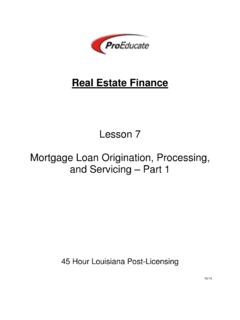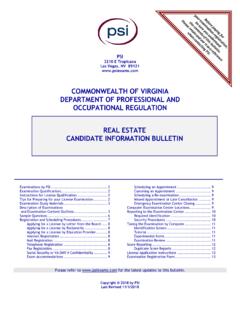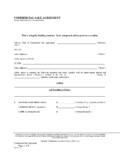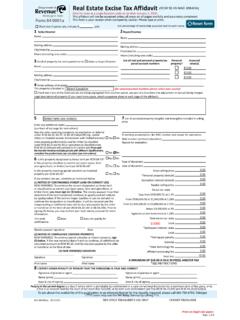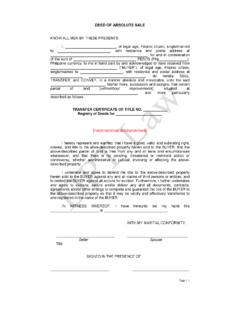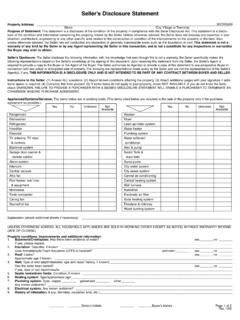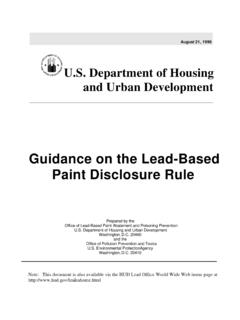Transcription of Property Measurement - ProEducate
1 ANSI Standard Details, Measurement Standards, Measurement Computations and Measuring Unique Structures (LREC Modules 1, 4, and 5) UNDERSTANDING ANSI-Z765 STANDARDS FOR SINGLE FAMILY RESIDENTIAL Measurement Living Area Inconsistency Comparative Unit or Units of Comparison National Measurement Standard Relating ANSI Terminology to Commonly Used Real Estate Agent Terminology Living Area Inconsistency The standards for measuring residential properties have been often guided by the users of the information such as government agencies and/or guided by norms expected by the professionals operating in a geographic market area. As a result, there was and still remains today inconsistencies amongst various professions involved in single family residential Measurement and area calculation, in addition to variances within the same profession operating in different market areas. Real estate agents and brokers are subject to the requirements of various professional boards; appraisers are subject to the guidelines of their users such as FHA, VA, Fannie Mae and Freddie Mac; architects are subject to their professional requirements; Property managers subject to their specific requirements; home builders are subject to their specific requirements; etc.
2 As you can see, there are numerous professions and organizations that compute and rely upon the labeling of area, and the calculation of area in a single family residence. The problem is the inconsistency in methodology and ultimately the outcome of the computations, often identified utilizing the same terminology, living area. For example, when one searches for definitions of living area, several different definitions appear along with a combination of qualifiers. Some definitions lump the term living area with gross , some with net . Even with the qualifiers in place, the definitions vary. Per the Air Force, Net Living Area is: Generally defined as the floor area of the living room, bedroom, bathroom, and kitchen/dining area, measured from the inside face of the room walls. Per AccuCoverage (insurance agency), Living Area is: The size of a home (in square feet) based upon the exterior dimensions.
3 This total should include the square footage of the main home as well as the square footage of the wing or addition if one has been specified. Per the Appraisal Institute s Dictionary of Real Estate Appraisal, 5th Edition, Gross Living Area is: Total area of finished, above-grade residential space; calculated by measuring the outside perimeter of the structure and includes only finished habitable, above-grade living space (finished basements and attic areas are not generally included in total gross living area. Local practices; however, may differ). You can see from the definitions presented, one of the primary problems is in the inconsistency of where to measure: inside vs. outside vs. middle of the wall. Other inconsistencies exist in defining the degree of finishes needed to be considered living area, the handling of stairs, the ceiling height requirements, accessibility, ventilation requirements, etc.
4 Additionally, there is the issue of the proper tools needed to compute area and just how accurate does one have to be! The definitions themselves even acknowledge that there is variance based upon local practices . Such a variety of definitions and Measurement techniques produce an inability to accurately communicate Property size information between professionals of various professions and members of the same profession in different locations. In Louisiana, several Realtor boards teach Measurement techniques and provide a living area definition as a means of creating consistency between members. A sample definition of living area from a Louisiana Board is as follows: Living Area is: our market term used to describe the finished, heated and cooled habitable contiguous area of a house measured from exterior walls. This definition provided consistency between real estate agents in the board s market area, however, did not provide for communication nationwide.
5 For instance, the heated and cooled requirement is reasonable for south Louisiana, however, to mandate HVAC as a living area requirement to a Property owner in Colorado is not reasonable. You can see how different market areas produce different requirements for living area based upon climate. Thus, a real estate agent/broker in south Louisiana is using the same term to communicate area, but definitions differ. The inconsistency in describing and computing area limits the ability to effectively communicate and market properties outside of the real estate s agent s market area. Comparative Unit or Units of Comparison Units of Comparison, per The Dictionary of Real Estate Appraisal, 5th ed., The components into which a Property may be divided for purposes of comparison, , price per square foot, front foot, cubic foot, room, bed, seat, apartment unit. Pricing a Property most often relies upon comparative unit methodology.
6 Comparative unit methodology is detailed in the Property Pricing module, but is also addressed here to explain and support the need for consistent and accurate area calculation. Without the ability to break down the comparable sales by a comparative unit, the real estate agent/broker data is limited to gross sales price. For example, when asked to list a house in a certain neighborhood, a necessary step is to gather the most recent sales transactions of similar properties. This is considered researching transactional data. The best comparable sales are the most recent transactions of properties that are the most similar to the subject in location and physical features. To continue, let s say that there are 15 transactions in the subject s neighborhood that have occurred in the last 6 months. The properties are similar and range in sales price from $200,000 to $400,000. Without utilizing comparative unit methodology, your pricing of the subject is based upon sales price.
7 However, it is difficult to realize why one buyer paid $200,000, one buyer paid $250,000, one buyer paid $300,000 and another paid $400,000. Comparative unit methodology allows a real estate agent/broker to break down the raw sales data into something more meaningful and isolate the motivation of price paid in each sale. There are a variety of units that could motivate a buyer to pay a price for a Property . In income producing properties the comparative unit is often related to sales price/income. In single family dwellings sold for owner occupancy, the comparative unit is often related to size. The real estate agent/broker s job is to determine the best and most consistent to apply to the subject Property . The analysis begins with breaking down the sales price paid, by a unit that is known about the comparable sales and the subject. For example: Sales Price / Square Feet of Living Area.
8 If the result of the application to each sale is a narrowing of the range, then it is reasonable that the agent has isolated a potential motivation of price between buyer and seller . The tightest range is created by the strongest comparative unit, or the unit that indicates what motivated the buyer to pay the price for the Property . In many cases, price paid for a single family residential dwelling is based upon unit value per square foot of living area. This should never be assumed, but should be proven by an analysis of comparable sales. Returning to our example, the real estate agent breaks each of the fifteen sales down by dividing sales price by living area and the resulting unit value range is from $100 to $110 per square foot of living area. The narrowing of the range from $200,000 - $400,000 sales price to a unit value range of $100 to $110 per square foot is substantial and indicates that living area was a prime motivation in price paid for the comparable sales.
9 Thus, application of a unit value of $100 to $110 to the subject s living area indicates a price/value conclusion. This example indicates the strength in comparative unit analysis; however, the strength is in consistency. If the comparable sales analyzed were not measured in a consistent manner with the subject, the strength of this analysis is diminished. For example, if the comparable sales were measured from the outside, and the real estate agent measured the subject from the inside, the subject Property would thus be underpriced, and the agent left money on the table. Worse the agent has potentially opened the door to a liability issue if the market norm is exterior Measurement . Let s take this a step further, and look at consistency between organizations. If the real estate agent measures from the inside and appraisers measure from the outside we have additional inconsistencies created.
10 In the current example, the inconsistency is caught if the sale is contingent upon financing. If the agent obtains a contract based upon interior square footage and the buyer s financial institution obtains an appraisal, with the appraiser measuring based upon exterior Measurement , the value would likely be different than the contract price. Again, if the real estate agent s method was inconsistent with the norm , this could open the door to liability issues. Appraisers often rely upon real estate agent data for comparable data, often measuring only the subject Property in their appraisal process. Appraisers are not required by Fannie Mae to measure comparable sales, but instead use sources such as Realtor Board s Multiple Listing Service (MLS) and other real estate agent listing services. If MLS data is used the appraiser must include the MLS #. An error or inconsistency in agent Measurement could also impact the appraisal outcome and again open the door to a liability issue.

